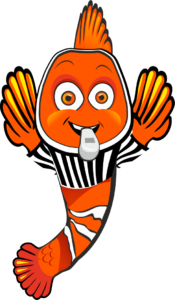
Basic Facts About Guppies
| Scientific Family: | Poecilia reticulata |
| Number of Guppy Fish Species Types: | There are over 300 types of guppies. |
| Average Life Span: | The average lifespan for a guppy is 3 to 5 years. |
| Typical Size: | Most guppies are approximately 1-2 inches in length. Females can grow slightly larger, but guppies are usually no bigger than 2.5 inches. |
| Colors: | Just as there are many different types, guppies come in almost countless colors and sport many different patterns. Male guppies are generally more vibrantly colored than their female counterparts, which usually have a more grey tone. Some guppies can have a metallic or iridescent quality as well. |
| Native To: | Guppies are a freshwater fish which were originally found in northeast South America. Since they are a hardy fish and have been introduced in many other regions, guppies can now be found throughout the world. Because they can survive in saltwater conditions, guppies are sometimes included in saltwater tanks. |
| Water Conditions Needed: | PH Level: Guppies can survive in pH values ranging from 5.5 to 8.5, but their ideal pH is 7.0-7.2. Gravity: 1.003-1.005 Water Temperature: 72-82°F. |
| What Do Guppies Eat?: | Guppies are omnivores, so they consume a diet comprised of both plants and animals. The majority of a guppy’s diet should consist of fish flakes, but make sure you purchase a type of fish flake high in protein and low in fillers. You can supplement fish flakes with food such as shrimp or bloodworms (frozen or live), as well as with vegetables like peas, lettuce, and cucumber. |
| Fish-Keeping Experience Level: | A beginner level fish-keeper is able to properly care for guppies. |
| Minimum Tank Size: | We recommend a 10 gallon tank as the minimum size for keeping guppies, however you can keep them in a 5 gallon tank if needed. |
| Tank Accessory Requirements: | You’ll need a good filtration system as well as a heater to maintain your guppies’ ideal temperature (75 to 82F). We also suggest adding plenty of live plants, rocks, and substrate to your tank, assuming it’s primarily a show tank and not a breeding tank for your guppies. If you want a breeding tank, you’ll want to keep your tank bare bottomed. Floating plants, such as Dwarf Water Lettuce or Frogbit are also highly recommended as the roots will give any guppy babies an adequate place to hide |
| Compatibility – Other Species: | Guppies are great social tank mates, as they are sociable and compatible with many fish species. Some of the most suitable fish to include with guppies include swordtail fish, platy fish, mollies, cory catfish, bristlenose pleco, gourami fish, angelfish, tetras, and rasbora fish. Be Careful with Angels if you’re looking to breed guppies though. Guppy fry will make a tasty snack for adult Angels. |
| Compatibility – Plants: | Guppies love live plants for their aquarium. The top recommended plants for your guppies include java moss, aptly named guppy grass, dwarf water lettuce, amazon sword plant, java fern, hornwort, moneywort, chain sword, and anubias barteri. If you are hoping to breed your guppies, you’ll want to also include decorative grass. |
| Compatibility – Do not Keep With These Species: | You will definitely want to avoid keeping your guppies with any predator or aggressive fish, such as barbs, south american and african cichlids, oscar fish, goldfish, killifish, and flowerhorn fish. |
| Can you breed Guppies? | Guppies are one of the easiest fish to breed, and if you keep a male and a female in the same tank, chances are you will have more guppies soon. Fertilization occurs in just brief contact between the male and female guppy during which the male passes a package of sperm known as spermatophores in the female. Guppies are live breeders, so the female carries the babies inside of an egg sac inside of her body then gives birth to a live fry (baby guppies). Once your female is pregnant, you’ll be able to see her abdomen swelling and you’ll begin to notice a darker spot towards her tail fin, known as a gravid spot. The typical gestation period for a female guppy is 21 to 30 days. When she is nearing the end of her pregnancy, you’ll need to place the female guppy in a breeding trap or remove her from the tank as soon as her fry is born so that she does not eat any of her young. If you choose a breeding trap, be sure to choose one that allows the female plenty of room to swim around. If it is too small it can stress the female guppy out, which can cause miscarriage. Breeding guppies can be a fun project over time. As you breed many generations, it’s easy to select the traits, genes and colors you like the best to develop your own unique strain. |
| Fun Fact: | Females can actually have multiple pregnancies over time from one fertilization encounter with a male guppy. Once she gives birth to her live fry, 21 to 30 days later, there’s a high likelihood that she’ll give birth to another round of young guppies. |
| Cost: | Most guppies can be purchased for $2.50 to $5. |

How will Guppies behave in your aquarium?
Guppies are small, peaceful, and sociable fish. Perfect for both beginner and experienced aquarists, guppies are both gentle and hardy. You can expect your guppies to remain in the open and highly visible for the most part, mainly swimming around the middle to top portion of your aquarium. This behavior along with the varied and bright colors and patterns sported by guppies add a beautiful dynamic to your tank. Guppies are prolific breeders, so if you are not interested in breeding your guppies make sure you keep all female or all male guppies in your tank.
How to acclimate your Guppies to your fish tank?
Gupppies can be acclimated by the floating method, detailed below. As Guppies are very hardy fish, they are easy to acclimate to your home aquarium.
Floating Method:
Step 1: Place the bag with your Gupipes in your aquarium & cut off the lights. While they likely had the light on in the pet store, keeping them close to the lights of your tank may unintentionally heat the water in their bag more than you wanted to.
Step 2: Let the bag float for 10-15 minutes to reach the same temperature as the tank.
Step 3: Cut a small hole in the bag and allow some of the water from your aquarium to flow in until it makes up roughly half of the water in the bag. Allow the bag to continue to float for about 5 more minutes, this will allow the Guppies to ease into the water parameters of your tank
Step 4: Release the Guppies into your tank!
Which Species Are Best To Pair With Your Guppy?
- Other Guppies
- Angelfish – But be careful, these are not recommended tank mates if you plan on breeding guppies
- Platy fish
- Mollies
- Cory catfish
- Tetras
- Rasbora Fish
Ohfishal Guppy Fish Tank Set Up
This is our ultimate checklist for a set up for Guppies. Of course, you can do this with more components, less components, or different components, but this is our all-in ohfishal recommendation. This set-up will run you around $220 (market prices will vary).
- Fish Tank – Aqua Culture 29 Gallon Aquarium Starter Kit with LED – If you want to buy an entire set with everything you need, this is a great option! Includes a LED light and a Tetra Filter. ($125)
- Species – 4 Guppies (whatever color/pattern variation you choose) ($15), 1 Angelfish ($25), 2 Swordtail fish ($6), 1 Platy fish ($5), 2 Mollies ($6), Java Moss ($12), Java Fern ($5), Amazon Sword Plant ($6), 2 Hornwort ($6), Moneywort ($4), 2 Chainsword ($10) (or substitute artificial decorations)
Frequently Asked Questions about Guppies
Guppies originated in the warm freshwater of South America, so yes, you will need a heater in order to maintain a water temperature of 75° to 82°F in your tank.
The short answer to this question is as many guppies as you want. Guppies get along great with other guppies. We recommend a minimum of a 5 gallon tank for 1 guppy, and then you will want to add approximately 2 gallons to your tank size per guppy you add. In general, it is recommended to keep a male to female guppy ratio of 2:1 in your tank. However, keep in mind that guppies are prolific breeders, so if you are not interested in breeding your fish you will want to keep all female guppies in your aquarium. It is not recommended to get all male guppies, as they can tend to get more aggressive in the absence of female guppies.
Guppies are quite sociable and docile by nature, so they do get along well with most other fish. The top recommended fish to pair with your guppies include swordtail fish, platy fish, mollies, cory catfish, bristlenose pleco, gourami fish, angelfish, tetras, and rasbora fish. Keep in mind that you do not want to keep larger, more aggressive fish in a tank with your guppies. This would include fish such as barbs, african cichlids, oscar fish, goldfish, killifish, and flowerhorn fish.
No, guppies cannot change gender like certain types of aquarium fish. You can tell the male and female guppies apart fairly easily. Male guppies are generally smaller and more brightly and vividly colored than females. Males also have a modified anal fin, known as a gonopodium, that appears longer and narrower than the female guppy’s anal fin. Finally, females have dark spot near their anal fin that is absent in males, This spot, called a gravid spot, gets darker during pregnancy.
